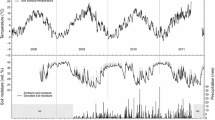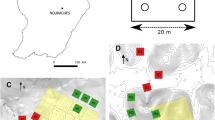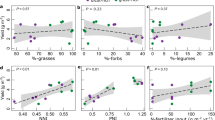Abstract
Canopy CO2 concentrations in a tropical rainforest in French Guiana were measured continuously for 5 days during the 1994 dry season and the 1995 wet season. Carbon dioxide concentrations ([CO2]) throughout the canopy (0.02–38 m) showed a distinct daily pattern, were well-stratified and decreased with increasing height into the canopy. During both seasons, daytime [CO2] in the upper and middle canopy decreased on average 7–10 μmol mol−1 below tropospheric baseline values measured at Barbados. Within the main part of the canopy (≥ 0.7 m), [CO2] did not differ between the wet and dry seasons. In contrast, [CO2] below 0.7 m were generally higher during the dry season, resulting in larger [CO2] gradients. Supporting this observation, soil CO2 efflux was on average higher during the dry season than during the wet season, either due to diffusive limitations and/or to oxygen deficiency of root and microbial respiration. Soil respiration rates decreased by 40% after strong rain events, resulting in a rapid decrease in canopy [CO2] immediately above the forest floor of about 50␣μmol mol−1. Temporal and spatial variations in [CO2]canopy were reflected in changes of δ13Ccanopy and δ18Ocanopy values. Tight relationships were observed between δ13C and δ18O of canopy CO2 during both seasons (r 2 > 0.86). The most depleted δ13Ccanopy and δ18Ocanopy values were measured immediately above the forest floor (δ13C = −16.4‰; δ18O = 39.1‰ SMOW). Gradients in the isotope ratios of CO2 between the top of the canopy and the forest floor ranged between 2.0‰ and 6.3‰ for δ13C, and between 1.0‰ and 3.5‰ for δ18O. The δ13Cleaf and calculated c i/c a of foliage at three different positions were similar for the dry and wet seasons indicating that the canopy maintained a constant ratio of photosynthesis to stomatal conductance. About 20% of the differences in δ13Cleaf within the canopy was accounted for by source air effects, the remaining 80% must be due to changes in c i/c a. Plotting 1/[CO2] vs. the corresponding δ13C ratios resulted in very tight, linear relationships (r 2 = 0.99), with no significant differences between the two seasons, suggesting negligible seasonal variability in turbulent mixing relative to ecosystem gas exchange. The intercepts of these relationships that should be indicative of the δ13C of respired sources were close to the measured δ13C of soil respired CO2 and to the δ13C of litter and soil organic matter. Estimates of carbon isotope discrimination of the entire ecosystem, Δe, were calculated as 20.3‰ during the dry season and as 20.5‰ during the wet season.
Similar content being viewed by others
Author information
Authors and Affiliations
Additional information
Received: 3 March 1996 / Accepted: 19 October 1996
Rights and permissions
About this article
Cite this article
Buchmann, N., Guehl, JM., Barigah, T. et al. Interseasonal comparison of CO2 concentrations, isotopic composition, and carbon dynamics in an Amazonian rainforest (French Guiana). Oecologia 110, 120–131 (1997). https://doi.org/10.1007/s004420050140
Issue Date:
DOI: https://doi.org/10.1007/s004420050140




